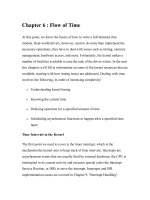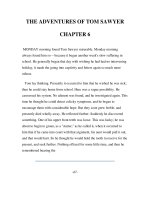PPT of group 7 about chapter 6
Bạn đang xem bản rút gọn của tài liệu. Xem và tải ngay bản đầy đủ của tài liệu tại đây (995.85 KB, 36 trang )
ORGANISING FRAMEWORK:
A COMPARATIVE
ASSESSMENT
Welcome to Group 7
recovery class
1
LET’S MEET OUR GROUP 7
Pham Thi Mai Dung
11191174
Mac Ngoc Anh
11190651
Luong Khanh Huyen
11192451
Tran Thai Khanh
11192550
2
1
Practical differences between leadership and
management across cultures
2
TABLE OF
CONTENT
3
4
5
Different forms of leadership styles across
cultures
GLOBE Leadership Study
Unconscious Bias towards various forms of
cultures
The Glass Ceiling
3
01
PRACTICAL DIFFERENCES
BETWEEN LEADERSHIP
AND MANAGEMENT
ACROSS CULTURE
4
What is leadership?
According to Kevin Kruse: “Leadership is a process of social influence, which
maximizes the efforts of others, towards the achievement of a goal.”
Source: Kevin Kruse (April, 2013). "What Is Leadership?”. Forbes
5
What is management?
According to Ricky W. Griffin: “Management can
be defined as a set of activities including planning,
organizing, leading, and controlling directed at an
organization’s resources with the aim of achieving
organizational goals in an efficient and effective
manner.”
Source: “What is management?”. Management Study HQ
6
What is the difference?
Leaders have people follow them.
V
S
Managers have people who simply work
for them.
Leadership is about motivating people
to comprehend and believe in the vision
you set for the company and to work
with you on achieving your goals.
Management is more about administering
the work and ensuring the day-to-day
activities are getting done as they should.
Leaders tend to praise success and drive
people.
Managers work to find faults.
Source: “The Difference Between Leadership and Management”. Next Generation
7
02
DIFFERENT FORMS OF
LEADERSHIP STYLES
ACROSS CULTURES
8
2.1. Democratic Leadership
Democratic leadership is exactly what it sounds like
the leader makes decisions based on the input of
each team member.
Creativity and innovation
are encouraged, which also
improves job satisfaction
among employees and
team members.
Constantly trying to achieve
consensus among a group
can be inefficient and, in
some cases, costly.
George Washington
(1732 – 1739)
Source: Bradon Becker (August 2016). "The 8 Most Common Leadership Styles & How to Find Your Own". blog.hubspot
9
2.2. Autocratic Leadership
Autocratic leadership is the inverse of democratic
leadership. In this leadership style, the leader makes
decisions without taking input from anyone who
reports to them.
Decisions are often made
quickly and strategically,
and teams are kept on track
as a result.
Employees can feel ignored,
restricted, and in the
absolute worst of cases
even abused.
Adolf Hitler
(1889 – 1945)
Source: Bradon Becker (August 2016). "The 8 Most Common Leadership Styles & How to Find Your Own". blog.hubspot
10
2.3. Laissez-Faire Leadership
Laissez-Faire is a French term that translates to “leave it
be”, which pretty accurately summarizes this hands-off
leadership approach. It’s the exact opposite of
micromanagement.
This level of trust and
independence is empowering
for teams that are creative
and self-motivated.
Chaos and confusion can
quickly ensue, especially if a
team isn’t organized or selfdirected.
Martin Van Buren
(1782 – 1862)
Source: Bradon Becker (August 2016). "The 8 Most Common Leadership Styles & How to Find Your Own". blog.hubspot
11
2.4. Strategic Leadership
Strategic leaders sit at the intersection between a company's main operations and its growth
opportunities. He or she accepts the burden of executive interests while ensuring that
current working conditions remain stable for everyone else.
This approach boosts morale
and leads to a high level of
trust, which results in better
employee performance and a
more positive company culture
overall.
Leaders who operate this way can
set a dangerous precedent with
respect to how many people they
can support at once, and what the
best direction for the company
really is if everyone is getting their
way at all times.
Source: Bradon Becker (August 2016). "The 8 Most Common Leadership Styles & How to Find Your Own". blog.hubspot
12
2.4. Strategic Leadership
Mother Teresa
(1910 -1997)
13
2.5. Transformational Leadership
Transformational leadership is always "transforming" and
improving upon the company's conventions. Employees might
have a basic set of tasks and goals that they complete every
week or month, but the leader is constantly pushing them
outside of their comfort zone.
Leaders are able to
establish a high level of
trust with employees
and rally them around
a shared vision or end
goal.
In environments where
existing processes are
valued, this desire to
change things up can
ruffle some feathers.
Nelson Mandela
(1918 – 2013)
Source: Bradon Becker (August 2016). "The 8 Most Common Leadership Styles & How to Find Your Own". blog.hubspot
14
2.6. Transactional Leadership
Leaders reward their employees for precisely the work they do.
Transactional leadership helps establish roles and responsibilities
for each employee, but it can also encourage bare-minimum
work if employees know how much their effort is worth all the
time.
PROS
Confusion and guesswork
are eliminated, because
tasks and expectations
are clearly mapped out by
the leader.
Due to the rigid environment
and expectations, creativity
and innovation may be
stifled.
CONS
Joseph McCarthy
(1908 – 1957)
Source: Bradon Becker (August 2016). "The 8 Most Common Leadership Styles & How to Find Your Own". blog.hubspot
15
2.7. Coach-Style Leadership
The leader focuses on identifying and nurturing the individual
strengths of each member on his or her team. They also focus on
strategies that will enable their team work better together.
Coach-Style leaders are
very inspirational and
effective at getting an
entire group invested in
a shared objective.
Due to their intense focus,
it’s easy for these leaders
to develop “tunnel vision”
and lose sight of other
important issues or tasks
that crop up.
Martin Luther King
(1929 – 1968)
Source: Bradon Becker (August 2016). "The 8 Most Common Leadership Styles & How to Find Your Own". blog.hubspot
16
2.8. Bureaucratic Leadership
This style of leadership might listen and consider the input of
employees - unlike autocratic leadership - but the leader tends to
reject an employee's input if it conflicts with company policy or
past practices.
There’s plenty of stability.
Since this is a systematized
approach to leadership, things
remain constant even through
personnel changes and other
shifts that threaten to rock the
boat.
It’s tempting to fall into the
“we’ve always done it this
way” trap. This approach can
be inflexible and neglect to
leave room for creativity or
ideas from employees.
Winston Churchill
(1874 – 1965)
Source: Bradon Becker (August 2016). "The 8 Most Common Leadership Styles & How to Find Your Own". blog.hubspot
17
03
GLOBE
LEADERSHIP
STUDY
18
3.1. The GLOBE Project
The GLOBE Project (Global Leadership and
Organizational Behavior Effectiveness Project)
is a study of cross-cultural leadership that
spans over 60 countries and cultures. The
Project was founded in 1993 by Robert J
House to analyze the organizational norms,
values, and beliefs of leaders in different
societies.
19
3.2. Six styles of the GLOBE project
01
02
03
Value-based style
Team-oriented
Participative
Source: Cornelius Grove (2005). "Nine Highlights from the GLOBE Research Project". Grovewell
20
3.2. Six styles of the GLOBE project
04
05
06
Humane
Autonomous
Self-protective
Source: Cornelius Grove (2005). "Nine Highlights from the GLOBE Research Project". Grovewell
21
04
UNCONSCIOUS BIAS
TOWARDS VARIOUS
FORMS OF CULTURES
22
4.1. Definition of unconscious bias
Unconscious biases are social
stereotypes about certain groups of
people that individuals form outside
their own conscious awareness.
Source : “Unconscious Bias Training”. Diversity. ucsf.edu
23
4.2. Factors contributing to implicit bias
Culture
The prevailing attitudes
of those around us, can
shape our biases.
Governance
The attitudes and
behaviors of leaders, can
have a significant impact
on unconscious bias.
Personal background
Especially for people from
insular backgrounds since
they’re less exposed to
difference, can impact our
perceptions and therefore
our biases.
Source: Casey Pechan (October 29,2021). “Unconscious Bias Examples and How to Overcome Them”. Betterworks
24
Unconscious
bias
4.3. The effect on the organization
Prevent companies from becoming diverse and
inclusive.
Influence who the company offers opportunities
for development.
Affect the customers and service users of profession.
Source: Casey Pechan (October 29,2021). “Unconscious Bias Examples and How to Overcome Them”. Betterworks
25









